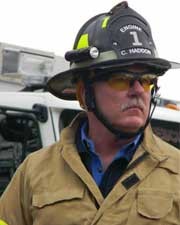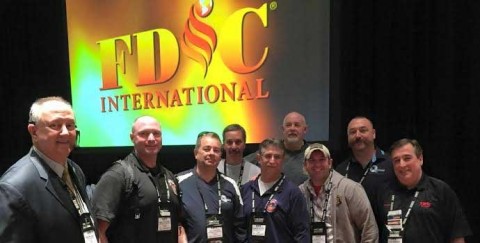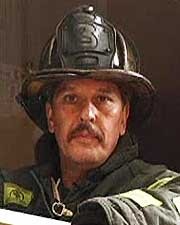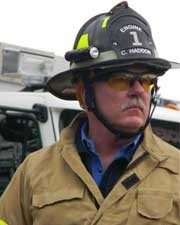Captain Aaron Heller and Ret. Captain Michael Clarke recently presented training at Tilton-Northfield Professional Firefighters Local 4659 in Tilton, New Hampshire. Below is an overview of the classes provided. We can bring these classes to your fire department!
Big Box Store Firefighting Strategies & Tactics
This course is a 3.5 hour lecture covering strategies and tactics of Big Box Stores. Topics include but are not limited to Engine Company operations regarding fire attack and extinguishment, line selection, line placement, crew responsibilities, and utilizing fire suppression systems. We also include Truck Company operations such as forcible entry, ventilation, and large area search techniques. Other topics include building construction, suppression systems, safety and survival techniques. Situational awareness for the Incident Commander, Company Officer, and line firefighters and in-depth coverage of strategy and tactics for Big Box Store fires are all included.Engine Company Operations: Mastering the Fire Floor
This course is a 3.5 hour lecture course is perfect for all levels of firefighters and is an interactivepresentation for engine company members. Topics for both residential and commercial operations include sizeup, line selection, positioning, riding assignments, common mistakes made, and much more. Following this course firefighters and officers will better understand their roles, responsibilities, and how to be an effective engine company members.
Bill Hopson recently presented training at Rhode Island Fire Instructors' Association in Exeter, Rhode Island. Below is an overview of the classes provided. We can bring these classes to your fire department!
Become a Better Fire Service Instructor on the Drill Ground
This highly interactive program is high energy, mega motivational and all about becoming a better Fire Service instructor on the Drill Ground. This presentation targets the active and engaged Fire Service instructor who seeks a traditional Instructor development block of training. It will help them become more capable, credible and competent. In this very interactive and unique type of training, the attendee will physically rotate through four evolutions, with each evolution containing a set of Instructor Development skills. These skills are specifically designed to improve the ability to supervise and teach students on the Drill Ground. The four rotations:- Live Burn
- SCBA/Smokehouse
- Specialized Skills
- Firefighter I/II,
Highly Interactive Training
Using specifically designed workbook and a unique, fast paced and highly motivational delivery, this program provides multiple opportunities for some attendees to deliver portions of the class, along with providing all attendees multiple opportunities to immediately improve on what they are doing and how they are doing it.This program has a specific focus on the Drill Ground. It requires the individual to be actively engaged in the presentation. There is no "down time," nor is there a test of wills for how long an attendee can sit still and stare at a large projection screen. If you are looking to improve on the Drill Ground, this class is for you!
Carl Haddon recent article for Fire Apparatus Magazine:
Are Your Hydraulic Extrication Tools and Your Extrication Program Instructor Compatible?
If your current rescue tools and your extrication training program are both 15 to 20 years old or older, then the answer to my question of compatibility is a resounding, "Yes," they are most likely compatible. Otherwise, you might be surprised. (Note: Fasten your seat belts, because this one is probably going to get me in trouble.) >Read More
Captain Aaron Heller has written another article for "Fire Engineering"
It Only Takes One: The Ego Driven Firefighter
By: Captain Aaron J. Heller
I believe that we in the fire service are truly blessed to live out many a child’s dream. We are still the one profession where people know and understand that our top priority is to help them in their most dire time of need. Collectively we have demonstrated this countless times throughout our storied history and we will continue to write amazing chapters to that in the future. Whether we consider it fortunate or not, firefighters are human with real emotions and a wide variety of thought processes. Now, by no means do I claim to have a formal education in psychology, but in the course of my 30 year career I have had the opportunity to work with and observe hundreds of firefighters. They are driven to be the best in their company or house, the best on the training grounds, the best in the department, and the best in the region. So I ask you, what’s driving them? I have asked myself this very question numerous times throughout my career and I have always hoped I came up with a true and unjaded answer. Are they driven by the desire to do good things and serve their communities? Is it that they feel the need to show how amazing the fire service can be and the tremendous deeds we perform across the globe each day? Is it the drive to possess skills that few will ever comprehend? Are they simply show-offs? Or is it something else? Read More Aaron J Heller Article
Carl Haddon most recent article written for FireApparatus.com is entitled "Rurally Speaking: Down South Rural—Way Down South" The following is an excerpt from this article.
Rurally Speaking: Down South Rural—Way Down South
Most who read this column have some involvement or interest in the rural fire service and its community. Here in the United States, we often find ourselves with similar rural challenges of departmental issues like staffing, morale, volunteer retention, training, and the seemingly ever shrinking department and district budgets. Costs of goods and services continue to rise, and our budget numbers and revenues never seem to quite keep time with our needs. All the while, we continue to work hard to mitigate our financial and operational challenges, so as to be the best that we can be for those we serve, while keeping our members as safe and as well trained as possible.For those of you who work tirelessly toward bettering your rural department, and have been on committees for, or dealt with some of the rural challenges listed above, I offer you the opportunity to buckle your seat belt, and join me on assignment here in rural Costa Rica. In the shadow of FDIC International, take in some of this country’s rural fire service challenges, and think of what you might do to help mitigate these daily operational issues. Perhaps your own plight may not seem so tough as you ride along with me through the harrowing streets of the pacific coast of rural Costa Rica.
My brother and sister bomberos (firefighters) here in Costa Rica are as passionate about their craft as you and I, or any dedicated volunteer or career firefighter anywhere in the world. The climate here is very tropical, with high humidity and temperatures that average in the mid to upper 80s most of the year. Here, there are basically two seasons; hot and dry. November to beginning of April is the hot season and April through October is the hot season. Wearing traditional bunker or turnout gear here is a real treat. More important is the availability of water. Hydrants outside of “cities” are few and very far between. Drafting water during the dry season can be challenging at best. When you can find a body of water to draft from, you often find yourself sharing that body of water with unhappy cocodrillos (crocodiles). No, I’m not kidding.
Click to read full article here.
Congratulations to the On Scene Training instructors who presented classes at the recently completed Fire Department Instructor's Conference (FDIC International 2015). The following is a list of instructors and the classes presented:
Aaron Heller - Big Box Store Firefighting Strategies and Tactics
Bill Hopson - Drill Ground Instructor Academy
Mike Ciampo - Truck Company Essentials / Ladder Operations
Carl Haddon - Understanding New Vehicle Technology Rescue Challenges
Ray Mc Cormack - Urban Firefighting Essentials
Eric Hankins - First Due Engineer
Art Bloomer - Special Rescue Operations for the Small Department
All of these instructors classes were very well attended and received. It was a great conference this year and we are happy with the survey results from the FDIC conference.
- 31,468 attendees from over 55 countries around the world
- 95% of attendees stated they will most likely attend FDIC Int'l 2016
- 94% of attendees rated the quality of exhibiting companies as good to excellent
- 97.7% of attendees rated the registration fee as fair to excellent for the value and benefit of the event
On Scene Training instructors enjoy sharing their knowledge in class and especially like networking and brotherhood outside the classroom!
Tony E Correia (On Scene Training Instructor) most recent article is entitled "Firefighting Risk, What Does It Mean To You?" The following is an excerpt from this article.
Firefighting risk: what does it mean to you?
Quite a few firefighters are aggravated and downright disgusted about overzealous “Safety Sissies” out there softening the fire service.I get it. When is enough, enough? It’s hard enough to do our job these days on the fireground with faster burning fuels and lightweight construction. How much more do they want to weigh us down with these overbearing safety restrictions? We’ve been doing the job for 10, 15, 20, 25 years and guess what, we’re still here!
We train regularly and learn from surviving each fire – so just leave us alone and let us do our $#@& jobs without coddling us. We know, “EVERYONE GOES HOME.”
So with that said, what is the risk to you and what is your personal acceptable level of risk?
I’m sure most of you have no intention of getting harmed or killed on the fireground, which I interpret as some level of risk aversion. What I and others are trying to figure out; and share with the fire service is how far are you willing to go to not be harmed or killed? “Let’s have this discussion so once and for all we can get the safety-nuts off our backs and let us do our job as god intended it to be done.”
Read full article here
Aaron Heller joins Fire Engineering periodically for their Humpday Hangouts covering different topics. His most recent Humpday Hangout featured hosts Steve Pegram and Aaron Heller talk training with E.J. Moscaro. They discuss training the younger generation of firefighters, mentorship and the role of veteran firefighters, drilling on the fundamentals, and more. They also discuss military veterans in the fire service and adapting to the job. Click here to view Humpday Hangout: Training.
Catch other Humpday Hangouts with Aaron Heller here.
Aaron Heller is an instructor and also owner of On Scene Training Associates, LLC. Aaron Heller began his fire service career in 1984. He is a captain in charge of training for the Hamilton Twp. NJ Fire District #9 where he has served since 1990. Capt. Heller is a NJ Level 2 instructor, fire official, and EMT. He is a past chief of the New Egypt Volunteer Fire Company and serves as Treasurer of the Plumsted Township Board of Fire Commissioners. Heller is a senior instructor with the Mercer County Fire Academy under the auspices of the Mercer County Community College. Capt. Heller instructs and has been the keynote presenter at several national, regional, and local training events throughout the United States and abroad. Captain Heller’s writings have been published in Fire Engineering Magazine, Fire & Rescue Magazine, The Fire Department Training Network, and several local publications. Captain Heller was recognized by the County of Ocean and the New Jersey State Assembly for his life-saving efforts in the rescue of an elderly woman from an apartment fire in 2004. Aaron is a founding member of the Jersey F.O.O.L.S chapter of the Fraternal Order Of Leatherhead Society.
Aaron Heller's most recent article written for www.fireengineering.com is entitled Firefighting in Big Box Stores. The following is an excerpt from this article.
As I write this, firefighters are preparing their Class A uniforms and planning a funeral to say goodbye to one of our own, taken from us far too early in another commercial building fire.
Whether you live in a big city, a suburban community, or a rural farm town, big box stores are moving in and making an impact on everything from the economy to traffic woes to the local fire department.
As these commercial hubs evolve, so must our understanding that these are not the bread-and-butter jobs to which many of us are accustomed. Even for the well-staffed and well-equipped fire departments, big box stores present hazards not normally encountered on a regular basis. Knowing this is half the battle. Understanding that the tactics we use on one- and two-family dwellings can't be relied on in this type of fire can prevent tragedy.
It's important to note that this article is not a recap of any highly publicized fires, nor is it an indictment of anyone involved in those incidents. Many reports have been written, studies conducted, and speeches given about those fires. The purpose of this article is to provide a framework for firefighters and fire officers to consider the next time the bells go off for a fire alarm, smoke in the building, or a structure fire at your local big box store.
As with any fire, understanding the building construction is imperative. If we don't know how it's constructed, how will we know how it may react under fire conditions? Furthermore, how can we predict fire and smoke travel? Read full article at fireengineering.com.
Michael Ciampo is an instructor for On Scene Training Associates. Lt. MICHAEL CIAMPO joined the fire service in 1979 as a volunteer and began his professional career in 1985, he is a lieutenant in the Fire Department of New York. Previously, he served with the District of Columbia Fire Department and Wyckoff, NJ VFD. He has a bachelor’s degree in fire science from John Jay College of Criminal Justice, NY. He is the lead instructor for the FDIC Truck Essentials H.O.T. program and teaches at numerous seminars around the country.. He wrote the Ladder chapter and co-authored the Ventilation chapter for Fire Engineering’s Handbook for Firefighter I and II (Fire Engineering, 2009) and is featured in “Training Minutes” truck company videos on www.FireEngineering.com. His video Bread & Butter Portable Ladders DVD is available from Pennwell. His monthly column ON FIRE is on the back page of FIRE ENGINEERING.
Mike Ciampo's most recent article written for www.fireapparatusmagazine.com is entitled Compartment Corner. The following is an excerpt from this article.
Welcome to this addition of “Compartment Corner.” From time to time we’ll feature articles on various types of tool compartments and their layouts. In addition, we’ll present photos and video of these compartments and the tools that are in them on different types of fire apparatus. Hopefully, by reading this column, you’ll be able to design a layout for your needs, find an answer to a mounting issue, requisition another type of tool, or look at the ways others have created solutions or innovations to make their compartments work for them.
Tower Ladder Saw CompartmentOn this Seagrave tower ladder, the left rear compartment is dedicated to the company’s saws. Having all the saws in one centralized area makes it easy for members to know their location in an emergency. The compartment is fitted with a roll out tray at the bottom, a center fixed shelf, and a top transverse shelf. Read full article here.
Carl Haddon is an instructor for On Scene Training Associates. Carl J. Haddon started his fire service career in 1983 in Southern California. Since the early 1980s he has also served as a fire/safety director for numerous racing organizations, including Penske Motorsports, NASCAR, USAC and Mickey Thompson Racing. Carl also does consulting work for several fire service equipment manufacturers.For the past 10 years Carl served as Asst. Chief and Fire Commissioner for North Fork F.D. in Idaho. He presently serves as a S.O.C. Rescue Specialist / Trainer for the State of Idaho, and is assigned to the Salmon (River) Task Force. As a level 2 instructor, Carl has taught fire / rescue programs and done emergency planning across the U.S., China, and the South Pacific. He has been an FDIC instructor since 2012, and is a monthly columnist for Fire Apparatus Magazine (To the Rescue & Rurally Speaking), and is a member of the Fire Apparatus & Emergency Equipment Magazine editorial advisory board
Carl Haddon's most recent article written for www.fireapparatusmagazine.com is entitled Rurally Speaking: Are the Days of Rural Volunteer EMS Personnel Numbered?. The following is an excerpt from this article.
In rural areas of the country, more people die from their illnesses or injuries as a result of no or not enough prehospital emergency medical services (EMS) care, than they do from improper emergency care. Is your state, county, or local authority having jurisdiction (AHJ) over EMS making it virtually impossible for your volunteers to get or maintain EMS certification?
Remember when holding certification for EMS meant attending a class for so many weeks, taking a final exam, taking a practical exam, and voila—you got a card? Remember when recertification meant simply maintaining continuing education units (CEUs) or a recertification class? This is no longer the case in many parts of the country. Consequently, the changes and the incessant new hoops to jump through are killing the EMS sector of volunteers across much of rural America. Isn’t recruiting volunteers difficult enough already? Read the full article here
Ray McCormack is an instructor for On Scene Training Associates. He will be presenting a class at the FDIC in Indianapolis, April 7 thru 12, 2014. Ray McCormack joined the FDNY in 1981 and is a lieutenant with Ladder 28 in Harlem. He is the co creator of Urban Firefighter Magazine and on the editorial board at FireEngineering Magazine. He delivered the keynote at the FDIC Fire Department Instructors Conference in 2009 and he is the author of Tactical Safety for Firefighters.
Ray McCormack's most recent article written for www.fireengineering.com is DICERS-VO for Extinguishment. The following is an excerpt from this article.
DICERS is a fire extinguishment model utilizing interior tactics to extinguish fires.
DICERS - VO
- D - Detect - Detect the location of the fire
- I - Isolate - Isolation of the fire area
- C - Confine - Confinement of the fire.
- E - Extinguish - Extinguishment of the fire.
- R - Rescue - Rescue of those effected by the fire and smoke.
- S - Search - Search of the fire area and adjoining spaces.
- V - Ventilation - Ventilation coordinated from within and as needed.
- O - Overhaul - Overhaul of the fire area for hidden extension.
The tactical and strategic components of DICERS should be accomplished in an order that allows for the greatest success of the remaining parts. The six primary action components--Detect, Isolate, Confine, Extinguish, Rescue, and Search--are implemented in conjunction with a fundamental understanding of the importance of an ongoing scene size-up to accomplish our strategic goals.
Your actions based upon the fire's extent and location within the structure, using ventilation discipline and entry air management, all impact our ability to obtain complete extinguishment and save lives.
Read full article here at fireengineering.com











